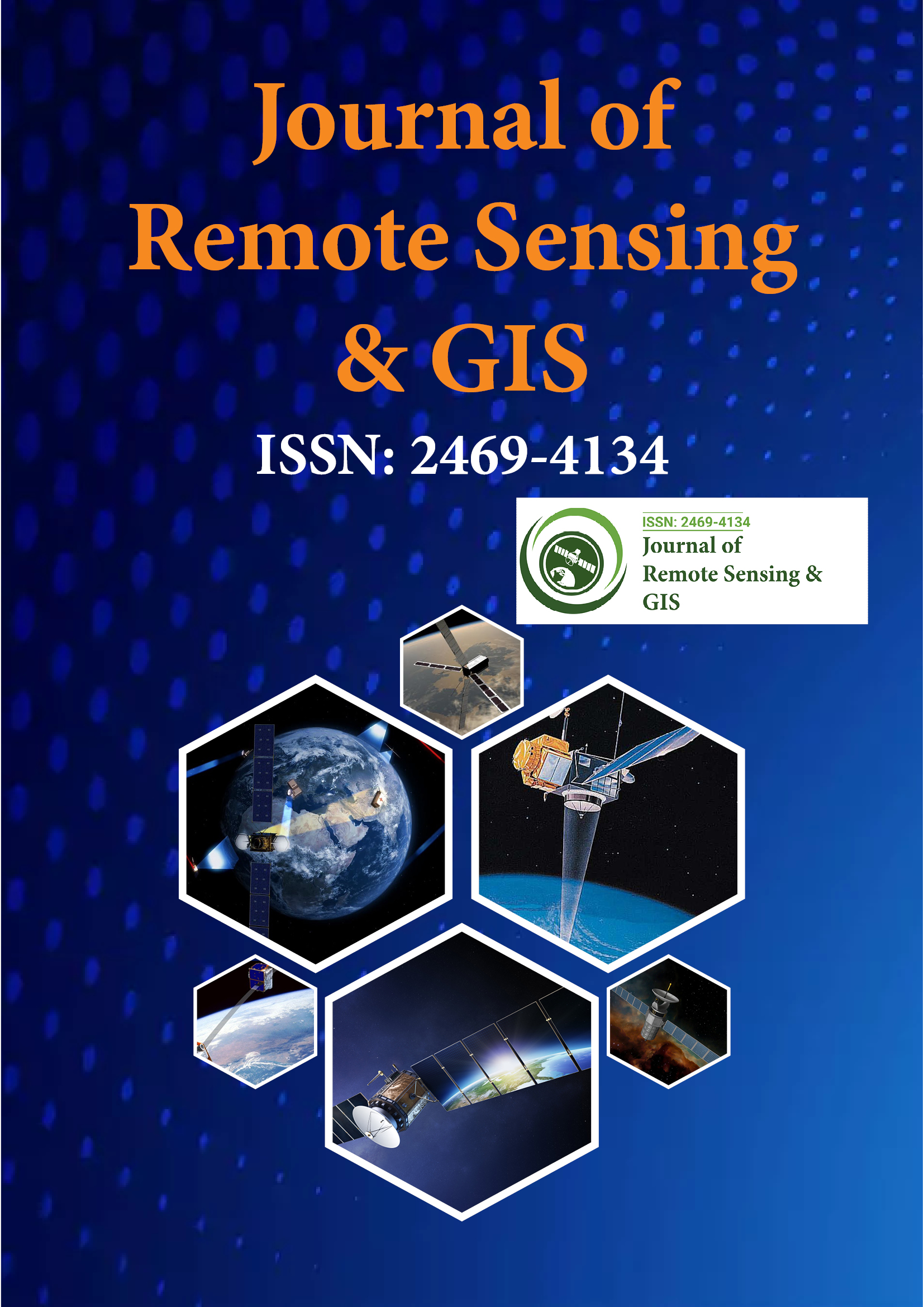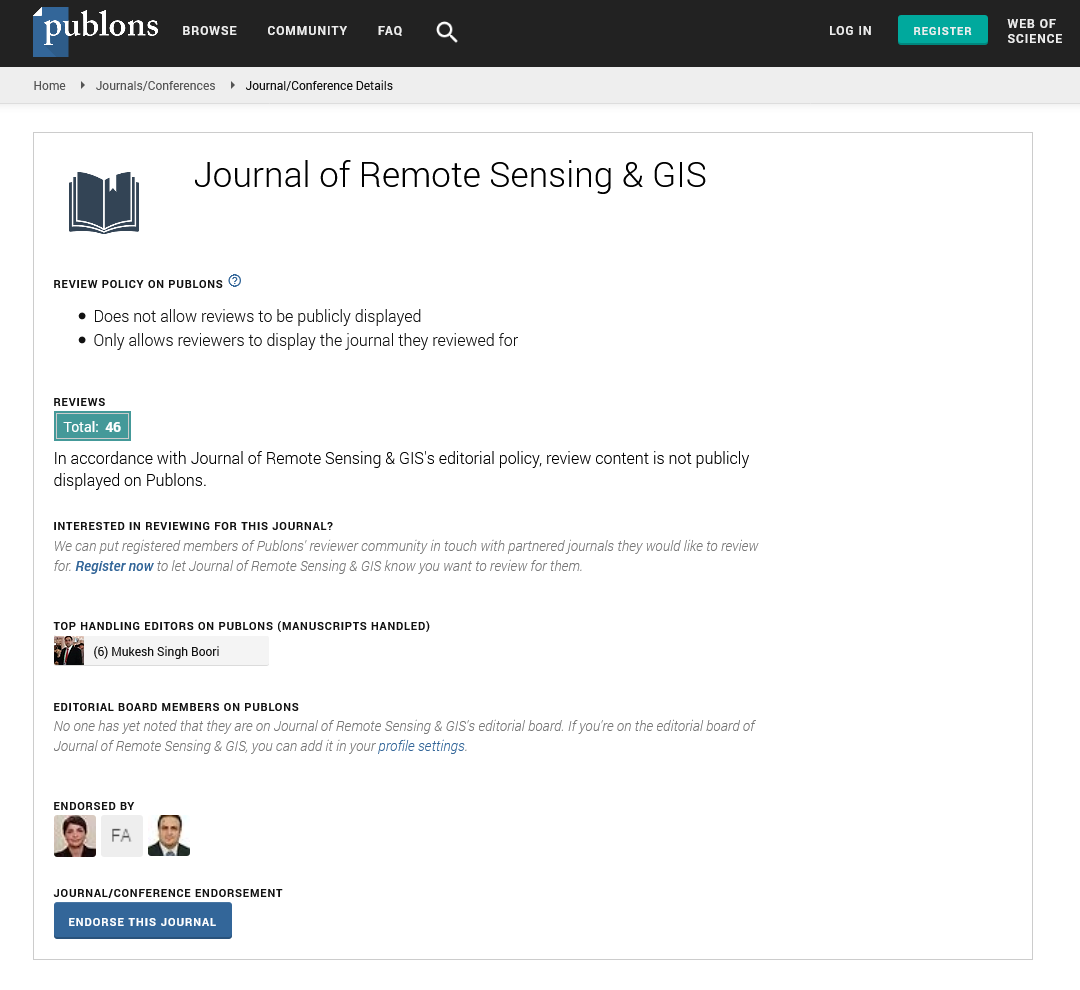Indexed In
- Open J Gate
- RefSeek
- Hamdard University
- EBSCO A-Z
- OCLC- WorldCat
- Publons
- International Scientific Indexing
- Euro Pub
- Google Scholar
Useful Links
Share This Page
Journal Flyer

Open Access Journals
- Agri and Aquaculture
- Biochemistry
- Bioinformatics & Systems Biology
- Business & Management
- Chemistry
- Clinical Sciences
- Engineering
- Food & Nutrition
- General Science
- Genetics & Molecular Biology
- Immunology & Microbiology
- Medical Sciences
- Neuroscience & Psychology
- Nursing & Health Care
- Pharmaceutical Sciences
Perspective - (2024) Volume 13, Issue 3
Advancing Early Warning Systems: Impact of Remote Sensing and GIS on Flood Management
Yucel Tousan*Received: 26-Aug-2024, Manuscript No. JGRS-24-26971; Editor assigned: 29-Aug-2024, Pre QC No. JGRS-24-26971 (PQ); Reviewed: 13-Sep-2024, QC No. JGRS-24-26971; Revised: 20-Sep-2024, Manuscript No. JGRS-24-26971 (R); Published: 27-Sep-2024, DOI: 10.35248/2469-4134.24.13.353
Description
Floods are among the most common and destructive natural disasters, causing significant loss of life, property damage and economic disruption worldwide. The need for accurate and timely flood risk mapping and early warning systems is important for minimizing the impact of floods. Remote sensing and Geographic Information Systems (GIS) offer powerful tools for monitoring, mapping and predicting flood risks. Flooding is a global threat that affects millions of people, especially in flood- prone areas such as river basins, coastal zones and urban regions with poor drainage systems. As a result, flood risk mapping and early warning systems are essential for disaster preparedness and mitigation. Traditionally, flood risk assessment has relied on historical flood records, topographic maps and hydrological models. However, these methods are limited by data availability, resolution and real-time applicability.
Remote sensing in flood risk mapping
Remote sensing refers to the acquisition of information about the Earth's surface from satellite or aerial platforms. It provides important data on hydrological variables such as precipitation, soil moisture and water bodies, which are key indicators of flood risks. Remote sensing technologies that play a significant role in flood risk mapping include optical, radar and thermal sensors.
Optical remote sensing: Optical sensors detect visible and near- infrared wavelengths, producing high-resolution images of the Earth’s surface. These images can be used to monitor land cover, water bodies and vegetation, which influence flood dynamics. Optical remote sensing has been extensively used for delineating flood extents and monitoring changes in water bodies. However, cloud cover during flood events can limit the effectiveness of optical sensors.
Radar remote sensing: Radar-based remote sensing systems, such as Synthetic Aperture Radar (SAR), are particularly useful in flood risk mapping due to their ability to penetrate clouds and operate in all weather conditions. SAR provides continuous monitoring of water levels, soil moisture and flood extent, making it an indispensable tool for flood assessment.
Thermal remote sensing: Thermal sensors measure surface temperature variations, which can indicate changes in water bodies and flood-prone areas. These sensors can complement optical and radar data by detecting temperature anomalies that may signal impending floods, such as increased soil saturation or rising river levels.
Role of GIS in flood risk assessment
Geographic Information Systems (GIS) facilitate the integration, analysis and visualization of spatial data from remote sensing platforms and other sources, such as topographic surveys and hydrological models. GIS is important for creating flood risk maps that show areas vulnerable to flooding based on multiple factors such as elevation, rainfall, land use and drainage networks.
Data integration and analysis: GIS enables the integration of diverse datasets, including remote sensing images, Digital Elevation Models (DEMs), hydrological data and meteorological records. By combining these datasets, GIS can generate flood risk maps that highlight areas at high risk of flooding based on various parameters, such as rainfall intensity, slope, land cover and proximity to water bodies.
Flood hazard mapping: Using GIS, spatial analysts can create flood hazard maps that depict flood-prone areas based on historical flood events and predictive hydrological models. These maps are essential for land-use planning, zoning regulations and infrastructure development. They also provide important information for emergency responders to identify high-risk zones and allocate resources effectively during flood events.
Flood vulnerability mapping: In addition to hazard mapping, GIS can be used to assess flood vulnerability by analyzing the exposure of populations, infrastructure and assets to flood risks. Vulnerability mapping considers factors such as population density, building materials, socio-economic conditions and access to emergency services. By combining hazard and vulnerability data, decision-makers can prioritize flood mitigation efforts in the most vulnerable areas.
Early warning systems
Early warning systems are vital for reducing flood-related casualties and damages. Remote sensing and GIS technologies have become indispensable in developing effective early warning systems by providing real-time data and predictive models.
Real-time data acquisition: Satellites equipped with remote sensing sensors can continuously monitor flood-prone areas and transmit data in near real-time. This data can be analyzed in GIS platforms to detect changes in water levels, precipitation patterns and land conditions. The ability to acquire real-time data enables authorities to issue timely warnings and evacuations.
Predictive modeling: Remote sensing data, when integrated into GIS-based hydrological models, can be used to predict flood events based on current and historical trends. These models simulate flood scenarios under various conditions, such as heavy rainfall or snowmelt, providing valuable insights into flood risks. Predictive models help authorities anticipate flood events and prepare response plans in advance.
Dissemination of warnings: Once a flood risk is identified, early warning systems can disseminate alerts to the public and authorities through various channels, including mobile apps, radio broadcasts and social media. GIS plays a key role in targeting these warnings by identifying the specific areas that are likely to be affected, ensuring that the right people receive timely alerts.
Conclusion
Remote sensing and GIS technologies have transformed flood risk mapping and early warning systems, providing real-time data and predictive models that help mitigate the impact of floods. By combining these technologies with hydrological models and early warning systems, authorities can improve disaster preparedness and response efforts. Despite ongoing challenges, continued advancements in remote sensing, GIS and data integration hold great promise for future flood management strategies.
Citation: Tousan Y (2024). Advancing Early Warning Systems: Impact of Remote Sensing and GIS on Flood Management. J Remote Sens GIS. 13:353.
Copyright: © 2024 Tousan Y. This is an open-access article distributed under the terms of the Creative Commons Attribution License, which permits unrestricted use, distribution and reproduction in any medium, provided the original author and source are credited.

